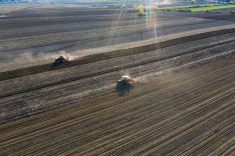A couple of years back I wrote an article on the basic facts about limestone. Since that time, I’ve taken a much closer look at the increasing need for limestone in Prairie crop production.
We often hear how Canada is running out of cropland — yes, already! In this country only 6.8 per cent of the land area is farmed and only 4.7 per cent is actually cropland. On a world basis, 38 per cent of land is farmed. In the U.S., 36 per cent of land is farmed, 75 per cent in the U.K., 56 per cent in China, 54 per cent in India and seven per cent in Russia. Now, Canada has a few cold areas and lots of hilly areas, but the amount of land farmed is still very little relative to most other countries. Canada’s agricultural acreage is made up of 189,000 farms.
Even our immediate prairie neighbours to the south, such as Montana, are getting concerned about increasing soil acidity and consequently lower crop yields. They point out in Montana that there are 15 counties with soil pH levels below 5.5 and some as low as 3.8. Well, I have news for everyone on the Prairies: we have lots of land, particularly in Alberta, with soil below pH 5.5, perhaps as much as 40 per cent in the Peace region of Alberta and B.C. It was in the northern Peace region that I came across a field with a failed canola crop and a pH of 3.5. The canola plants remained in the rosette stage.
Read Also

Seasoning for Korea’s culinary wave
Not unlike K-pop, Korean cuisine has become part of the international cultural tidal wave called Hallyu, Saskatchewan chef and writer dee Hobsbawn-Smith says.
Factors that exacerbate soil acidity include minimal or zero till, which results in the top three inches (7.5 cm) of soil being much more acidic than deeper layers due to the effect of fertilizers and crop residue. Higher nitrogen fertilization for higher yields means some of our cropland is acidifying at a faster rate.
Acidic soil surfaces can delay or reduce crop seed germination and establishment, particularly for canola, by days or even a week or so. Acidic soils below pH 5 or as low as 3.5 in the surface layers also inhibit the availability of molybdenum (Mo). This microelement is needed at less than a few ounces per acre to regulate the crop plants’ nitrogen metabolism — that is, the conversion of ammonia to nitrate and back — leading to N starvation.
Soil acidity also inhibits the breakdown of some crop herbicide products — meaning they remain active in the soil for a much longer time.
Cheap to buy, expensive to get
Limestone rock is extremely plentiful in Canada in countless billions of tons but its Prairie availability for agriculture seems somewhat restricted. Most provinces, including Alberta and Manitoba, have limestone quarries but the bulk of the lime industry is in Ontario and Quebec. Limestone is a high-bulk, low-cost commodity, even as lime — but transport is expensive. Some 85 million tons are processed annually in Canada primarily for the building, steel, pulp, paper and mining industries. Alberta used to have a liming subsidy program as late as the 1970s, but that was, for some reason, discontinued.
Ideally, most Prairie soils should be between a pH of 6 and 7 — a pH that allows good access to both macro- and micronutrients. If you intend growing nitrogen-fixing alfalfa, your soil pH should be a minimum of 6.5 and preferably above 7. Alfalfa will grow at pH 5.5 or even 5 — but it does not fix nitrogen. You may as well save money and grow an acid-tolerant legume, or just plain grass.
When the soil pH dips below 5.5, both wheat and barley will lose yield potential. Many years ago, I soil-sampled two side-by-side quarter sections at Calmar, Alta., just south of Edmonton. The grower’s wheat target yield was 60 bushels. One of the fields with a pH over 6 came in at just over 60 bushels; the other, with a pH of 5.4, came in at 50 bushels after being given the same fertilizer regime. I questioned the grower, who told me that on the more acidic quarter he had often fertilized the more acidic fields with frequent leftover amounts of ammonium sulphate. He was a fertilizer dealer many years back. In other words, a classic example of soil acidification with lots of N fertilizer application. All in all, the principal factors that lead to increased soil acidity are:
• high-yielding crops receiving high N rates;
• lots of rainfall in some years leading to leaching of basic elements into the subsoil;
• soils with acidic parent material; and
• organic matter decay from the crop residues.
Limestone itself is an abundant sedimentary rock primarily made up of calcium carbonate or, sometimes, a mixture of calcium carbonate and magnesium carbonate. The magnesium component, usually at around 10 per cent, gives it the name dolomitic limestone. If the limestone is heated, it becomes quicklime; it releases the carbon dioxide-forming calcium carbonate (CaCO3) and becomes calcium oxide (CaO), otherwise known as quicklime, which will readily absorb water to become slaked lime (CaO + H2O → Ca(OH)2). Slaked lime will eventually absorb CO2 from the air to again become calcium carbonate. It’s simple chemistry. Vast amounts of quicklime, 60-70 per cent by weight, is used in making cement.
The amount of crushed limestone best for crop application, needed to raise the soil pH to higher levels — say, from 5.0 to 6.0 — will vary depending on soil type. Fine-textured soils and Grey Wooded soils need one to two tons an acre of fine crushed limestone. Dark Grey and Black soils need two to three tons an acre. Rich-textured organic and peaty soils may need up to four tons an acre. Cost of this crushed limestone is reported to be around $40 a ton, sans transport. Do not bet on it, though.
If you have acidic soil, at around a pH 4 to 5, referred to as strongly acid, liming should be evaluated. Liming is particularly needed now that most of you have moved from conventional tillage to minimal or zero till. Soil surfaces, as previously stated, could be as low as 3.5 in the top few inches. If you have doubts about liming, you might consider applying up to two tons of lime per acre on perhaps 10-40 acres of cropland that you know has a pH of 5 or perhaps even less. Barley yields may jump from 40-50 bushels an acre to perhaps 60-70. Wheat at 50 bushels an acre could be as high as 70 bushels an acre. A 10-bushel yield increase of wheat will give a return of $100 — enough to pay for the two tons of crushed limestone an acre. The limed acre will maintain a pH increase that will last 10-15 years or more — or even longer, since it may well have improved soil tilth and organic matter.
One advantage of raising soil pH is a possible reduction in clubroot infection of canola crops. A negative effect of raising soil pH is that the higher pH is more favourable to the verticillium stripe disease of canola.
For further information on the topic of liming, check on Alberta Agriculture’s excellent publication on the web, “Liming of Acid Soils” (Agdex 534-1).
















